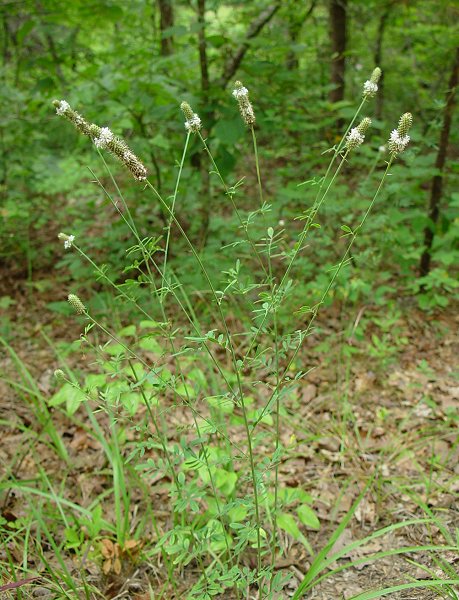Dalea candida Willd.
White Prairie Clover

Native
CC = 8
CW = 5
MOC = 60
© DETenaglia
Dalea candida Willd.White Prairie Clover | |
 |
Native CC = 8 CW = 5 MOC = 60 |
© DETenaglia |
|
Family - Fabaceae/Faboideae Habit - Perennial forb with a knotty, dark brown to black caudex above a stout taproot. Stems - Arching to erect, to 70 cm, single or multiple from base, unbranched or sparingly branched above the midpoint, prominently ribbed, glabrous, sparsely gland-dotted.
Leaves - Alternate, stipulate, odd-pinnate, 1.5-6.0 cm long, sometimes appearing in fascicles, with 2 smaller trifoliate leaves at the base of the main leaf. Stipules needle-like, 1-5 mm long, glabrous. Leaf blades with the rachis 10-30 mm long, gland-dotted, glabrous, those of the main leaves with 5-11 leaflets. Leaflets 5-30 mm long, 2-7 mm wide, those of the lower leaves often larger than those of the upper leaves, linear to narrowly oblong or elliptic-oblanceolate, usually tapered at the base and tip, occasionally blunt but with a minute, sharp extension of the midvein at the tip, the upper surface glabrous, the undersurface gland-dotted but otherwise glabrous.
Inflorescences - Dense terminal indeterminate spikes 2-6 cm long, the axis not visible between the flowers, ovoid to cylindric, the stalk 5-11 cm long, the axis glabrous or occasionally minutely and inconspicuously hairy (viewing requires removal of flowers or fruits), with scattered bracts and a whorl closely subtending the spike, these persistent, 4-10 mm long, 0.5-1.2 mm wide, linear to long-tapered above a slightly expanded base, green, gland-dotted, more or less pale-margined, grading into the bracts subtending flowers, these prominent in bud but shed early, 5-6 mm long (longer than the calyces of the associated buds), 1.5-2.0 mm wide, long-tapered above a narrowly elliptic-oblanceolate to obovate base, gland-dotted, the margins thin and pale.
Flowers - Calyces with the tube 1.9-2.5 mm long, glabrous, the ribs often reddish-tinged, gland-dotted around the rim, the lobes 1.0-1.8 mm long, linear to narrowly triangular, often reddish-tinged, the margins minutely hairy. Petals 5, white, the banner with the expanded portion 1.5-2.0 mm long, the wing and keel petals similar, attached along the rim of the stamen tube, the expanded portion 1.8-2.0 mm long. Stamens 5, the filament tube 2-3 mm long, the free filaments 2-3 mm long, the anthers yellow.
Fruits - Short legumes included in or somewhat exserted from the persistent calyx, 2.5-4.0 mm long, firm above the membranous basal portion, with a transverse ring of glands separating the two regions.
Flowering - June - September. Habitat - Upland prairies, glades, tops of bluffs, openings of upland forests, savannas, pastures, cemeteries, railroads, and roadsides. Origin - Native to the U.S. Lookalikes - None when flowering. Other info. - This species can be found throughout most of Missouri, though it appears to be absent from several northwestern counties. Its wider range occupies the central half or more of the continental U.S. and Canada. It is not found in states on the east or west coast. The plant is relatively easy to identify from its pinnate leaves and white flower clusters. Photographs taken off Hwy H, Shannon County, MO., 7-18-03 (DETenaglia); also at Little Lost Creek Conservation Area, Warren County, MO, 7-8-2020, and Don Robinson State Park, Jefferson County, MO, 6-20-2023 (SRTurner). |